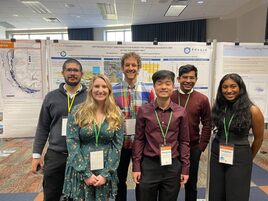|
See more field and lab photos
|
We study how modern and ancient sedimentary environments evolve(d) in response to external forces such as climate, tectonics, sea level change, and human impacts. If you are interested in working with us or learning more, you can reach Matt at: malkowski at jsg dot utexas dot edu Learn more about who we are |
Highlights from our lab:
2023
Our study of the Earth's surface response to the erosion of its largest canyons is now available in open access with Geophysical Research Letters
MM awarded an Academic Alliance research grant with Sandia National Labs to investigate the sedimentology of a melting delta on the Alaska North Slope
|
UT Sed Heads show their stuff at the JSG Research Symposium Learn more about the group and what we're working on here Not pictured: Mingang Hao (but his poster is!) |
We received an NSF Award for a collaborative project with Dr. Judith Pardo Perez to investigate basin records in the Patagonian Andes (Chile) that hold clues to the timing of early Cretaceous south Atlantic Ocean oxygenation and its impact on marine fauna.
see more photos from our recent field season
see more photos from our recent field season
2022
Malkowski Research Group joins the Detrital Geochronology Lab and Dr. Glenn Sharman's team
MM awarded American Chemical Society grant to study paleogeographic controls on organic carbon burial in the Austral Basin, Patagonia (Argentina)
Sending mixed signals. Our study of deep sea deposits shows that coastal processes on broad continental shelves are effective sediment mixers, regardless of sea level. And look how well they can be unmixed!
Sustainable Sand: Finding the delicate balance between 'seds and society'. We were recently awarded funding by the California State Coastal Conservancy to investigate the sustainability of sand mining in San Francisco Bay by 'fingerprinting' the sediment that moves around the region. Sand as a resource is in high demand because it is used as aggregate for new roads and buildings. It is also important for maintaining ecosystems and replenishing beaches, especially as sea level rises. Is the San Francisco Bay sediment routing system "in-balance"? How much sand can be sustainably extracted? Sampling photos here.
My colleague Glenn Sharman and I published this study on how often a sand(stone) deposit records its own depositional age through detrital zircon geochronology. Some sand deposits are better than others at revealing their age; what controls this?
This website uses marketing and tracking technologies. Opting out of this will opt you out of all cookies, except for those needed to run the website. Note that some products may not work as well without tracking cookies.
Opt Out of Cookies